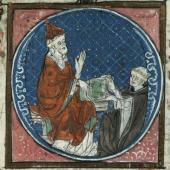-

Dominican Bibles (1)
-

Dominican Bibles (2)
-

Concordance of the Bible (1)
-

Concordance of the Bible (2)
-

Concordance of the Bible (3)
-

Concordance of the Bible (4)
-

Biblical Commentary - St Thomas Aquinas on the Four Gospels (1)
-

Biblical Commentary - St Thomas Aquinas on the Four Gospels (2)
-

Biblical Commentary - St Thomas Aquinas on the Four Gospels (3)
The Dominicans and the medieval Bible
800 years of Dominican books
The study of the Bible in the Middle Ages was in two main areas, firstly the provision of commentaries on the various books and secondly the production of the Vulgate text in the most accurate form. In the twelfth century large size Bibles were made for monastic houses, probably mainly used for reading by the lector during meals in the refectory, and many of these suggest efforts to ensure the accuracy of the text. Also in the twelfth century many commentaries were produced, notably the Glossa ordinaria, initiated by the cathedral school of Laon, which provided commentaries on all the books. In the early thirteenth century when the Dominican order was founded the scholarly study of the Bible had shifted to the universities, above all that of Paris. An accurate version of the text was established there, with standardised chapter numbering, and the production of a word concordance. The so-called Paris text of the Bible was established by ca 1225 with a standardised series of prologues to the books and with chapter divisions. From the 1230s the Dominicans became involved, and initiated by Hugh of Saint-Cher at Paris they produced a concordance. Also several thirteenth-century Dominicans wrote biblical commentaries, including Albertus Magnus, Hugh of Saint-Cher and Thomas Aquinas.
Image reproduced by kind permission of the Syndics of the Fitzwilliam Museum, Cambridge.